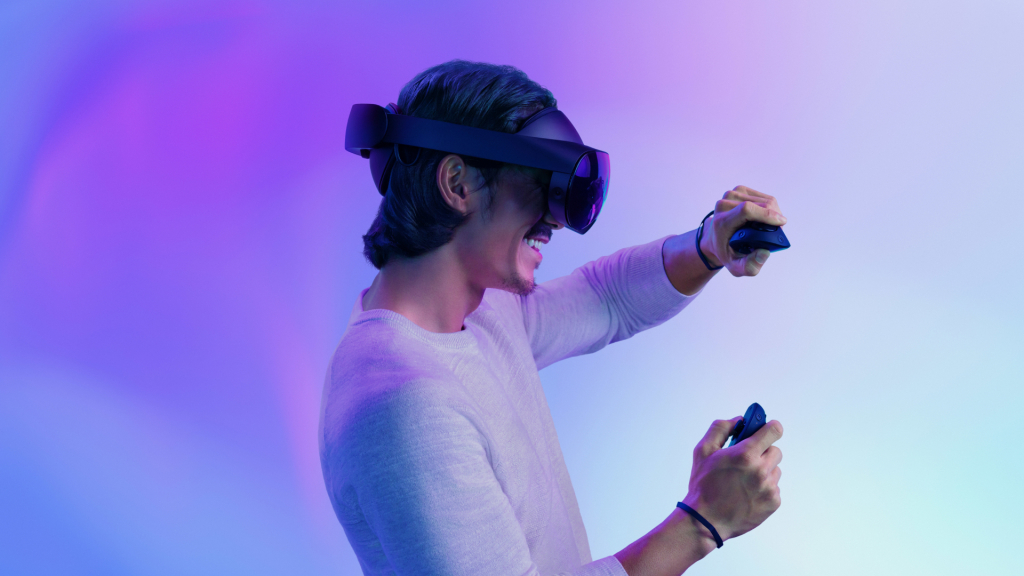Meta's Quest Pro can now track your tongue, but it's not the update the headset needs most
Face tracking will be niche until more people can afford it

The Meta Quest Pro has received an unexpected update – its face tracking can now follow your tongue movements.
One of the main hardware upgrades featured in the Meta Quest Pro is face and eye tracking. Thanks to inbuilt cameras, the headset can track your facial features and translate your real-life movements onto a virtual avatar. Because it's perfectly mimicking your mouth flaps, nose twitches, and eye movements, the digital model can feel almost as alive as a real human at times – at least in my experience with the tech.
Unfortunately, this immersion can break down at points, as the tracking isn’t always perfect, with one fault many users noticed being that it can’t track your tongue. So if you wanted to tease one of your friends by sticking it out at them, or lick a virtual ice cream cone you couldn’t – until now.
Meta has released a new version of the face-tracking extension in its v60 SDK, which finally includes support for tongue tracking. Interestingly this support hasn’t yet been added to Meta avatars – so you might not see tongue-tracking in apps like Horizon Worlds – but it has already started to be added to third-party apps by developers.
Rleased new #VRCFT modules for new #QuestPro v2 facial tracking with support for tongue.Supports (Air)Link and VD via VDX (when VD adds support) using the ALXR Local module and ALXR clients with the ALXR Remote moduleYou can download from here https://t.co/F37U2zA8is#VRChat pic.twitter.com/sUmfLaXVpNDecember 14, 2023
This includes developer Korejan (via UploadVR) who develops a VR Face Tracking module for ALXR – an alternative to apps like Virtual Desktop and Quest Link, which help you connect your headset to a PC. Korejan posted a clip of how it works on X (formerly Twitter).
All the gear and nothing to do with it
Meta upgrading its tech’s capabilities is never a bad thing, and we should see tongue-tracking rolling out to more apps soonish – especially once Meta’s own avatar SDK gets support for the feature. But this isn’t the upgrade the feature needs. Instead, face tracking needs to get into more people’s hands, and there needs to be more software that uses it.
Before the Meta Quest 3 was released I seldom used mixed reality – the only times I did were as part of any reviews or tests I did for my job. That’s changed a lot in the past few months, and I’d go as far as to say that mixed reality is sometimes my preferred way to play if there’s a choice between VR and MR.
Sign up for breaking news, reviews, opinion, top tech deals, and more.
One reason is that the Quest 3 offers significantly higher quality passthrough than the Quest Pro – it’s still not perfect, but the colors are more accurate, and the feed isn’t ruined by graininess. The other, far more important reason is that the platform is now brimming with software that offers mixed reality support, rather than only a few niche apps featuring mixed reality as an aside to the main VR experience.

Even though they’ve been out for the same length of time on Meta hardware, there isn’t the same support for face tracking or eye tracking. That’s despite all the talk before the Quest Pro released of how much realism these tools can add, and how much more efficiently apps could run using foveated rendering – a technique where VR software would only properly render the part of the scene you’re looking at with your eyes.
The big problem isn’t that face tracking isn’t good enough – if it can track your tongue it definitely is impressive – it’s (probably) the Quest Pro’s poor sales. Meta hasn’t said how well or badly the Pro has performed financially, but you don’t permanently cut the price of a product by a third just four months after launch if it’s selling like hotcakes – it fell from $1,500 / £1,500 / AU$2,450 to $999.99 / £999.99 / AU$1,729.99. And if not many people have this headset and its tracking tools, why would developers waste resources on creating apps that use them when they could work on something more people could take advantage of?
For face tracking to take off like mixed reality has it needs to be brought to Meta’s budget Quest line so that more people can access it, and developers are incentivized to create software that can use it. Until then, no matter how impressive it gets, face tracking will remain a fringe tool.
You might also like

Hamish is a Senior Staff Writer for TechRadar and you’ll see his name appearing on articles across nearly every topic on the site from smart home deals to speaker reviews to graphics card news and everything in between. He uses his broad range of knowledge to help explain the latest gadgets and if they’re a must-buy or a fad fueled by hype. Though his specialty is writing about everything going on in the world of virtual reality and augmented reality.